INTRODUCTION
Chromolaena DC. belongs to the subtribe Praxelinae R.M. King & H. Rob. of Eupatorieae Cass. (Hind & Robinson, 2007; Robinson et al., 2009; Rodríguez Cabeza et al., 2014; Rivera et al., 2016), one of the most recently derived lineages of Asteraceae (Mandel et al., 2017, 2019; Susanna et al., 2020). This genus includes herbs or shrubs with opposite leaves and lilac, blue or white corollas. The genus is morphologically circumscribed by a cylindrical involucre composed of 4-6 series of imbricated phyllaries, flat to scarcely convex receptacle, obpyramidal cypselae, distinct carpopodium and pappus of numerous capillary bristles (King & Robinson, 1987; Bremer, 1994; Grossi et al., 2020). Chromolaena includes ca. 166 species (King & Robinson, 1987; Hind & Robinson, 2007) distributed in warm and temperate-warm regions of the Neotropics, from southern United States, through Central America up to southern South America in Argentinian Pampas (King & Robinson, 1987; Freire, 2008; Rodríguez Cabeza et al., 2014; Avila et al., 2022). The genus is most diverse in the Cerrado region of Brazil, and the Andes.
Chromolaena was first described by Candolle in 1836 with C. horminoides DC. as type species. In 1873, Bentham included it into the large genus Eupatorium L. For a long time, this was the accepted taxonomic viewpoint for many botanists, especially in the Neotropics (e.g. Baker, 1876; Robinson, 1918; Cabrera et al., 1996).
In 1987, King and Robinson published a detailed systematic survey of Eupatorieae, which is considered a new taxonomic starting point for this tribe. In this work, the genus Eupatorium was restricted to ca. 40 species from North America and Eurasia, and the remaining species were included into ca. 100 new or reinstated genera. The separation of the genus Eupatorium was made based on morphological characters, and has been supported by molecular evidence (Schilling et al., 1999; Schmidt & Schilling, 2000). Eupatorium is defined by campanulate involucres, phyllaries subimbricated arranged in 3-4 series, cypselae almost exclusively glanduliferous, anthers collars lacking annular thickenings in the cells, and no distinct carpopodium (King & Robinson, 1970; Bremer, 1994; Hind & Robinson, 2007).
King & Robinson (1970; 1987) recognized Chromolaena at genus level, including species of Eupatorium sect. Chromolaena (DC.) Benth. ex Baker, Osmia Schultz-Bip., and Eupatorium sect. Cylindrocephala DC. Although this is currently the accepted taxonomic criteria (Hind & Robinson, 2007; Freire & Ariza Espinar, 2014; Christ & Rebouças, 2020), some South American botanists in the 1990’s and early 2000 did not follow this classification; such was the case of the Flora of Paraguay (Cabrera, 1996), and the Catalogue of the Southern Cone (Freire, 2008). While maintaining Eupatorium’s broad concept, Cabrera (1993) described Eupatorium amambayense Cabrera within Eupatorium sect. Cylindrocephum DC. considering this section a synonym of Chromolaena (Cabrera & Klein, 1991). The current number of Chromolaena species for Paraguay is 19 (Table 1).
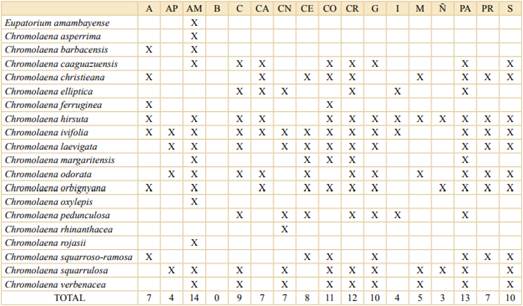
Table 1 Species of Chromolaena and Eupatorium amambayense in Paraguay. Abbreviations A: Alto Paraguay, AP: Alto Paraná, AM: Amambay, B: Boquerón, C: Caaguazú, CA: Caazapá, CN: Canindeyu, CE: Central, CO: Concepción; CR: Cordillera; G; Guairá; I: Itapúa, M: Misiones, Ñ: Ñembecú, PA: Paraguarí, PR: Presidente Hayes, S: San Pedro.
As part of an ongoing revision of southern South American Chromolaena, our main objective is to establish the taxonomic identity of Eupatorium amambayense and transfer it to Chromolaena, based on a detailed morphological analysis.
MATERIALS AND METHODS
Specimens and high-resolution images from the following herbaria BA, BM, G, L, LP, MICH, MPU, P, SI, and US (Thiers, 2022) were examined. Dichotomous keys from general studies were used to differentiate genera (King & Robinson, 1970; Hind & Robinson, 2007; Christ & Ritter, 2019) and local keys were used to differentiate species (Cabrera et al., 1996). We follow Harris & Harris (1994) for general terminology and Grossi et al. (2020) for involucral and floral features. Characters of taxonomic importance within Praxelinae (King & Robinson, 1987; Hind, 2014; Grossi, 2020) were analysed and cross-checked with information from protologues and type specimens. Morphological features of Chromolaena and Praxelis Cass. (King & Robinson, 1987; Hind, 2014; Grossi, 2020) were analysed using a Zeiss Discovery.V20 stereo microscope, images were taken using a Axiocam 512 camera and stack using ZEN 2 Software. The following specimens were analysed:
Chromolaena hirsuta (Hook. & Arn.) R.M. King & H. Rob.: ARGENTINA, Santa Fe, General Obligado, 5-III-2022, Gutiérrez 1790 (BA). PARAGUAY, Alto Paraguay, Estancia Roma, III-1917, Rojas 2948 (LP). Misiones, San Fernando, 5-V-1945, Rojas 12634a (LP). Paraguarí, Calixtro, II-1919, Rojas 3453 (LP).
Chromolaena laevigata (Lam.) R.M. King & H. Rob.: PARAGUAY, Central, Fernando de la Mora, 15-IV-1961, Pedersen 5908 (LP). Paraguarí, Camino de Ipacaray a Pirayú, 12-III-1972, Schinini 4284 (LP).
Chromolaena squarrulosa (Hook. & Arn.) R.M. King & H. Rob.: PARAGUAY, Guairá, Yegua-porá, 6-X-1952, Montes 16570 (LP).
Praxelis clematidea R.M. King & H. Rob. ARGENTINA, Catamarca, Ambato, camino a El Rodeo, 23-IV-2022, Salgado 5 (BA). PARAGUAY, San Pedro, Colonia Primavera, 23-III-1956, Woolston 114a (SI).
Praxelis kleinioides (Kunth) Sch. Bip.: PARAGUAY, Amambay, San Luis, III-1908/1909, Fiebrig 5160 (L).
Praxelis ostenii (B.L. Rob.) R.M. King & H. Rob.: PARAGUAY, Concepción, Itapucumí, III-1917, Rojas 2952 (LP, SI).
RESULTS AND DISCUSSION
Currently, Eupatorium is restricted to North America and Eurasia and includes species without distinct carpopodium or imbricated phyllaries (King & Robinson, 1970; Bremer, 1994; Hind & Robinson, 2007), both characteristics present in Eupatorium amambayensis. This species can be included in Praxelinae by its deciduous involucres (phyllaries falling when reaching maturity) which differentiate it from other related subtribes of Eupatorieae like Hebecliniinae, Critoniinae, Fleischmanniinae, and Ageratinae (Rivera et al., 2016; Grossi, 2020).
Praxelinae includes seven genera: Chromolaena DC., Eitenia R.M. King & H. Rob., Eupatoriopsis Hieron., Lomatozona Baker, Osmiopsis R.M. King & H. Rob., Praxeliopsis G.M. Barroso, and Praxelis Cass. (Table 2).
Praxeliopsis, Eupatoriopsis, Eitenia, and Lomatozona are endemic to Brazil (King & Robinson, 1987). With the exception of Lomatozona, all of these genera have conical or columnar receptacles (Barroso, 1949; King & Robinson, 1979; 1987) that differ from the flat to slightly convex receptacle of E. amambayense. Lomatozona has filiform style branches and poorly developed carpopodium (King & Robinson, 1979), unlike E. amambayense, that has slightly broadened in distal half style branches and distinct carpopodium.
The genus Osmiopsis is endemic to Haiti. It has opposite leaves that contrast with the alternate leaves of E. amambayense and is the only genus of the tribe that has style branches with broadened tips (King & Robinson, 1975), which are absent in the species of our study.
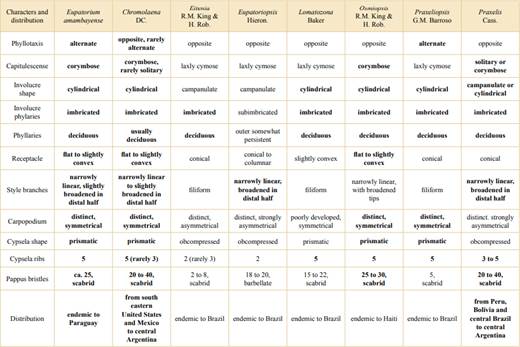
Table 2 Comparison among the genera of Praxelinae and Eupatorium amambayense. In bold, shared characteristics between E. amambayense and the genera of Praxelinae.
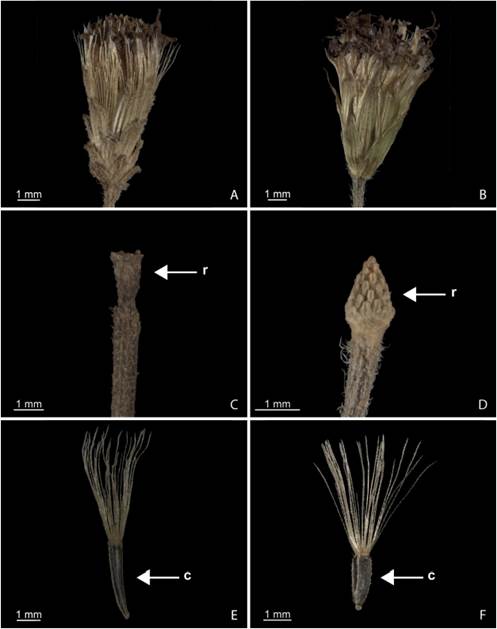
Fig. 1 Characters of taxonomic importance for Praxelinae in Paraguay. Chromolaena: A, cylindrical involucre with imbricated phyllaries. C, flat to slightly convex receptacle. E, obpyramidal cypselae. Praxelis: B, campanulate involucre with subimbricated phyllaries. D, conical receptacle. F, obovate cypselae. Abbreviations: r, receptacle; c, cypselae. Color version at http://www.ojs.darwin.edu.ar/index.php/darwiniana/article/view/1077/1287
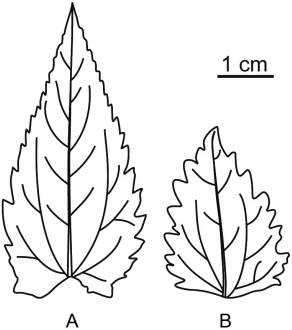
Fig. 2 A, leaf of C. amambayensis. B, leaf of C. hirsuta. (A, adapted from Cabrera 1993: 238; B, specimen US 01668847). Drawings by V.G. Salgado.
The two genera of Praxelinae present in Paraguay are Praxelis and Chromolaena (King & Robinson, 1987; Salgado et al., 2020). Praxelis has campanulate involucres, subimbricated phyllaries and obovate cypselae laterally inserted in a conical receptacle; whereas Chromolaena has cylindrical involucres, imbricated phyllaries and (most species) obpyramidal cypsela with basal insertion to a flat to slightly convex involucre (King & Robinson, 1987; Hind, 2014; Grossi et al., 2020) (Fig. 1). Eupatorium amambayense has imbricate phyllaries, cylindrical involucres and obpyramidal cypselae which fit it accurately within Chromolaena.
Nineteen species of Chromolaena are currently described for Paraguay; only one species, C. hirsuta (Hook. & Arn.) R.M. King & H. Rob. has phyllaries with differentiated apex and alternate ascendant (not pendular) leaves like Eupatorium amambayense. As stated in the protologue, E. amambayense can be recognized by its glabrous or glabrescent laminas with cordate bases in opposition to C. hirsuta`s loosely hirsute laminas with rounded bases (Cabrera, 1993; Cabrera et al., 1996) (Fig. 2).
TAXONOMIC TREATMENT
Chromolaena amambayensis (Cabrera) Grossi, V.G. Salgado & D.G. Gut., comb. nov. Eupatorium amambayense Cabrera, Candollea 48: 237. 1993, not Eupatorium amambayense Hassler. TYPE: Paraguay, Amambay department, “altaplanitie et declivibus Sierra de Amambay”, January 1907-1908, T. Rojas & E. Hassler 10089 (holotype G G00381699 [photo!]; isotypes G 00381698 [photo!], G 0381977 [photo!], BM 000096285 [photo!], MICH 1107346 [photo!], MPU 015582 [photo!], P 00742281 [photo!]).
Shrubs 0.3-0.6 m tall, xylopodium present. Stems erect, internodes 5-10 mm long, densely leafy up to capitulescence, striated, densely lanuginose. Leaves alternate, sessile or shortly petiolate, petioles 0.5-1 mm long, lamina 2.5-5 × 1.5-2.5 cm, ovate, base cordate, stem-clasping, apex acute, margin serrate, slightly recurved, with large teeth at the base, gradually smaller towards the apex, 5-veined, veins abaxially prominent, minor veins forming a fine reticulum, coriaceous, glabrous and shiny adaxially, glabrous or glabrescent with a slight pubescence, mainly on the veins abaxially. Capitulescences corymbiform, capitula sessile or shortly pedunculate. Involucres 5.5 mm × 2.5 mm, cylindrical, phyllaries 18-20, imbricate, arranged in 4-5 series, inner gradually longer than outer, broadly oblong, 1.1-2 mm wide, apex acute and briefly mucronate. Florets 9-10, corollas 3.5-4 mm long, tubular-funnelform, lilac. Cypselae 3 mm long, obpyramidal, 5-costate, Pappus of capillary bristles, ca. 3.5 mm long, white.
Distribution and habitat
Chromolaena amambayensis is known only from the Sierra de Amambay, a low range of mountains along part of the Brazil-Paraguay border, where it inhabits elevated fields.
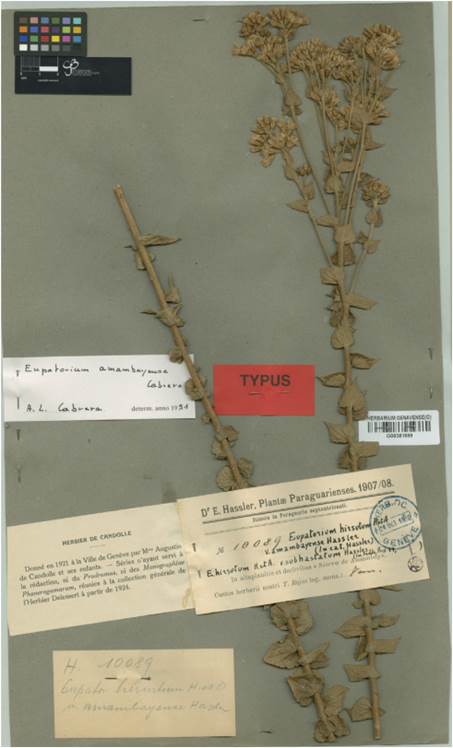
Fig. 3 The holotype of Eupatorium amambayense Cabrera, deposited in G (Catalogue des herbiers de Genève (CHG). Conservatoire & Jardin botaniques de la Ville de Genève. 17-08-2022 (http://www.ville-ge.ch/musinfo/bd/cjb/chg). Color version at http://www.ojs.darwin.edu.ar/index.php/darwiniana/article/view/1077/1287
Additional specimens examined
PARAGUAY, Amambay, Sierra de Amambay, December 1907-1908, Rojas & Hassler 9762 (MPU, BM, paratypes).
Cabrera (1993) cites as holotype material in G with locality “altaplanitie et declivibus Sierra de Amambay”, collected by T. Rojas & E. Hassler with number 10089 (Fig. 3). Although there are three specimens in G (i.e. G00381698, G00381700, G00381699) that match the protologue information, there is an image of G00381699 in the protologue indicating it as the holotype. There is one specimen (G00381977) with matching collector and number but different location information: “campis pr. [prope] Estrella” probably referring to Colonia Estrella in the Amambay region. Cabrera also mentions in the protologue that the holotype and a gathering from the same locality by T. Rojas & E. Hassler with number 9762 (MPU 015581, G) have handwritten annotations with the name “amambayensis”, which he chose to use as the species name.
The transfer of Eupatorium amambayense as Chromolaena amambayensis totals 20 species of Chromolaena for Paraguay (Table 1). This species and three others of the genus (C. asperrima (Sch. Bip. ex Baker) R.M. King & H. Rob.; C. oxylepis (DC.) R.M. King & H. Rob. and C. rojasii (Hassl.) R.M. King & H. Rob.) are endemic to the Amambay department, a highly diverse region and endemism hotspot (Peña Chocarro & De Egea, 2018).












 uBio
uBio 

